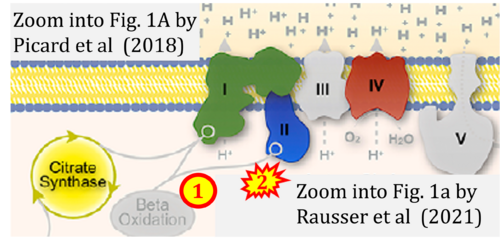Bindra 2021 Sci Rep
| Bindra S, McGill MA, Triplett MK, Tyagi A, Thaker PH, Dahmoush L, Goodheart MJ, Ogden RT, Owusu-Ansah E, R Karan K, Cole S, Sood AK, Lutgendorf SK, Picard M (2021) Mitochondria in epithelial ovarian carcinoma exhibit abnormal phenotypes and blunted associations with biobehavioral factors. Sci Rep 11:11595. https://doi.org/10.1038/s41598-021-89934-6 |
Bindra S, McGill MA, Triplett MK, Tyagi A, Thaker PH, Dahmoush L, Goodheart MJ, Ogden RT, Owusu-Ansah E, R Karan K, Cole S, Sood AK, Lutgendorf SK, Picard M (2021) Sci Rep
Abstract: Malignant tumor cells exhibit mitochondrial alterations and are also influenced by biobehavioral processes, but the intersection of biobehavioral factors and mitochondria in malignant tumors remains unexplored. Here we examined multiple biochemical and molecular markers of mitochondrial content and function in benign tissue and in high-grade epithelial ovarian carcinoma (EOC) in parallel with exploratory analyses of biobehavioral factors. First, analysis of a publicly-available database (n = 1435) showed that gene expression of specific mitochondrial proteins in EOC is associated with survival. Quantifying multiple biochemical and molecular markers of mitochondrial content and function in tissue from 51 patients with benign ovarian masses and 128 patients with high-grade EOC revealed that compared to benign tissue, EOCs exhibit 3.3-8.4-fold higher mitochondrial content and respiratory chain enzymatic activities (P < 0.001) but similar mitochondrial DNA (mtDNA) levels (- 3.1%), documenting abnormal mitochondrial phenotypes in EOC. Mitochondrial respiratory chain activity was also associated with interleukin-6 (IL-6) levels in ascites. In benign tissue, negative biobehavioral factors were inversely correlated with mitochondrial content and respiratory chain activities, whereas positive biobehavioral factors tended to be positively correlated with mitochondrial measures, although effect sizes were small to medium (r = - 0.43 to 0.47). In contrast, serous EOCs showed less pronounced biobehavioral-mitochondrial correlations. These results document abnormal mitochondrial functional phenotypes in EOC and warrant further research on the link between biobehavioral factors and mitochondria in cancer.
• Bioblast editor: Gnaiger E
Correction: beta-Oxidation and CII ambiguity
- beta-Oxidation is shown to be linked to CI (correct) and CII (wrong) in a Figure published in refs. [1,2,3]. For clarification, see ref. [4].
- Picard M, Prather AA, Puterman E, Cuillerier A, Coccia M, Aschbacher K, Burelle Y, Epel ES (2018) A mitochondrial health index sensitive to mood and caregiving stress. Biol Psychiatry 84:9-17. - »Bioblast link«
- Bindra S, McGill MA, Triplett MK, Tyagi A, Thaker PH, Dahmoush L, Goodheart MJ, Ogden RT, Owusu-Ansah E, R Karan K, Cole S, Sood AK, Lutgendorf SK, Picard M (2021) Mitochondria in epithelial ovarian carcinoma exhibit abnormal phenotypes and blunted associations with biobehavioral factors. Sci Rep 11:11595. - »Bioblast link«
- Rausser S, Trumpff C, McGill MA, Junker A, Wang W, Ho SH, Mitchell A, Karan KR, Monk C, Segerstrom SC, Reed RG, Picard M (2021) Mitochondrial phenotypes in purified human immune cell subtypes and cell mixtures. Elife 10:e70899. - »Bioblast link«
- Gnaiger E (2023) Complex II ambiguities ― FADH2 in the electron transfer system. MitoFit Preprints 2023.3.v6. https://doi.org/10.26124/mitofit:2023-0003.v6
Labels:
Enzyme: Complex II;succinate dehydrogenase
Pathway: F

